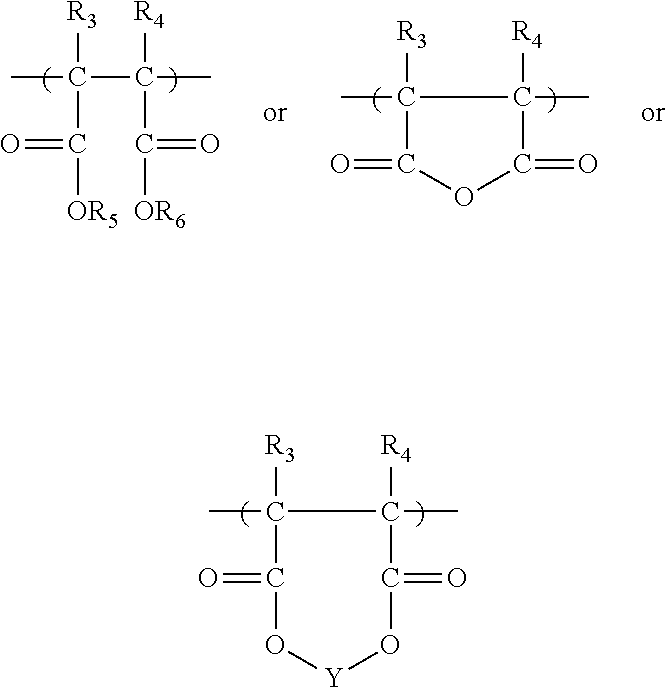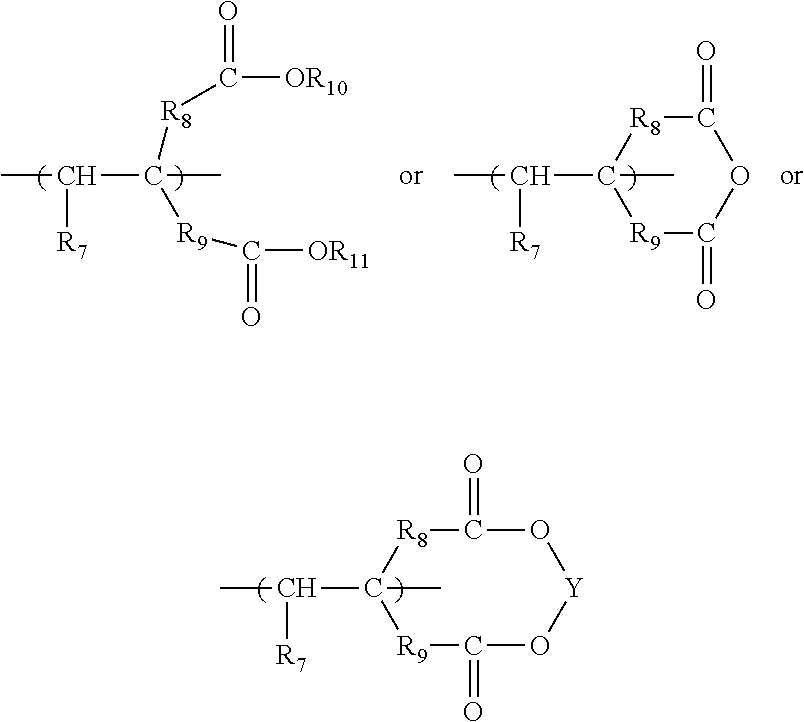Polymeric compositions
a polymer composition and composition technology, applied in the field of polymer compositions, can solve the problems of hydrocarbon contamination in soils, affecting and affecting the quality of the final product, so as to reduce the evolution of ammonia and enhance the performance of pesticides
- Summary
- Abstract
- Description
- Claims
- Application Information
AI Technical Summary
Benefits of technology
Problems solved by technology
Method used
Image
Examples
example 1
Exemplary Synthesis
[0065]Apparatus:
[0066]A cylindrical reactor was used, capable of being heated and cooled, and equipped with efficient mechanical stirrer, condenser, gas outlet (open to atmosphere), solids charging port, liquids charging port, thermometer and peroxide feeding tube.
[0067]Procedure: Water was charged into the reactor, stirring was initiated along with heating to a target temperature of 95° C. During this phase, itaconic acid, sodium methallylsulfonate, sodium allylsulfonate, and maleic anhydride were added so as to make a 50% w / w solids dispersion with the following monomer mole fractions:[0068]maleic: 45%[0069]itaconic: 35%[0070]methallylsulfonate: 15%[0071]allylsulfonate: 5%
When the reactor temperature reached 95° C., vanadium oxysulfate was added to give a vanadium metal concentration of 25 ppm by weight. After the vanadium salt fully dissolved, hydrogen peroxide (as 50% w / w dispersion) was added continuously over 3 hours, using the feeding tube. The total amount...
example 2
Exemplary Synthesis
[0073]Apparatus:
[0074]Same as Example 1
[0075]Procedure: Water was charged into the reactor, stirring was initiated along with heating to a target temperature of 100° C. During this phase, itaconic acid, sodium methallylsulfonate, sodium allylsulfonate, and maleic anhydride were added so as to make a 70% w / w solids dispersion with the following monomer mole fractions:[0076]maleic: 45%[0077]itaconic: 50%[0078]methallylsulfonate: 4%[0079]allylsulfonate: 1%
When the reactor temperature reached 100° C., vanadium oxysulfate was added to give a vanadium metal concentration of 25 ppm by weight. After the vanadium salt fully dissolved, hydrogen peroxide (as 50% w / w dispersion) was added continuously over 3 hours, using the feeding tube. The total amount of hydrogen peroxide added was 7.5% of the dispersion weight in the reactor prior to peroxide addition. After the peroxide addition was complete, the reactor was held at 100° C. for two hours, followed by cooling to room tem...
example 3
Preparation of Tetrapolymer Partial Salts
[0081]A tetrapolymer calcium sodium salt dispersion containing 40% by weight polymer solids in water was prepared by the preferred free radical polymerization synthesis of the invention, using an aqueous monomer reaction mixture having 45 mole percent maleic anhydride, 35 mole percent itaconic acid, 15 mole percent methallylsulfonate sodium salt, and 5 mole percent allylsulfonate. The final tetrapolymer dispersion had a pH of slightly below 1.0 and was a partial sodium salt owing to the sodium cation on the sulfonate monomers. At least about 90% of the monomers were polymerized in the reaction.
[0082]This sodium partial salt tetrapolymer was used to create 40% solids in water calcium salts. In each instance, apart from the sodium present in the tetrapolymer mixture, appropriate bases or base precursors (e.g., carbonates), or mixtures thereof were added to the aqueous tetrapolymer at room temperature to generate the corresponding salts. Specifi...
PUM
| Property | Measurement | Unit |
|---|---|---|
| mole percent | aaaaa | aaaaa |
| mole percent | aaaaa | aaaaa |
| temperatures | aaaaa | aaaaa |
Abstract
Description
Claims
Application Information
 Login to View More
Login to View More - R&D
- Intellectual Property
- Life Sciences
- Materials
- Tech Scout
- Unparalleled Data Quality
- Higher Quality Content
- 60% Fewer Hallucinations
Browse by: Latest US Patents, China's latest patents, Technical Efficacy Thesaurus, Application Domain, Technology Topic, Popular Technical Reports.
© 2025 PatSnap. All rights reserved.Legal|Privacy policy|Modern Slavery Act Transparency Statement|Sitemap|About US| Contact US: help@patsnap.com



